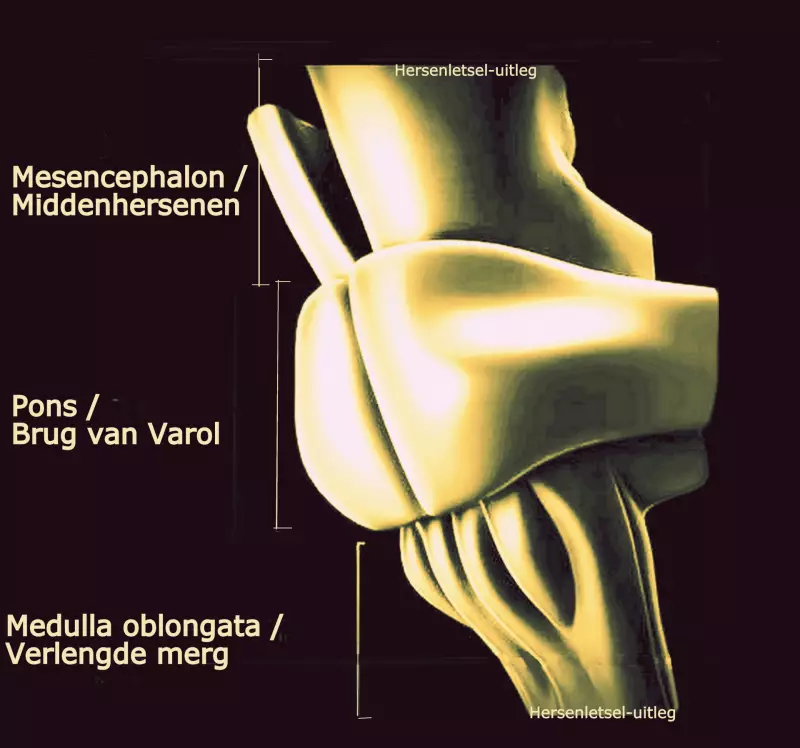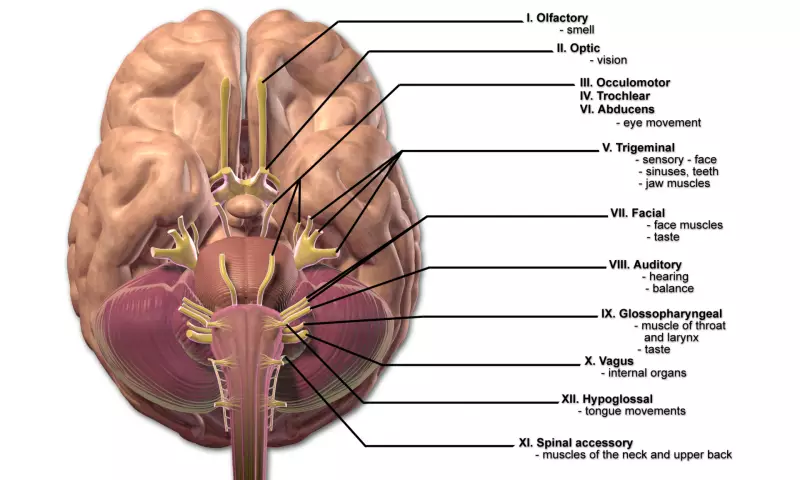Medulla Oblongata

Foreword: The brain works together as one whole. Brain functions are spread throughout the brain areas and result from the exchange
between the areas. However, complaints can be identified per brain area.
Medulla Oblongata is Extended Spinal Cord
Other names for the medulla oblongata are: medulla prolongata, bulbus cerebri.
Part of the brainstem
The medulla oblongata is the lower part of the brain stem. We can distinguish the brainstem into three parts.
From top to bottom:
- the midbrain (mesencephalon),
- the pons (Bridge of Varol),
- the medulla oblongata.

The medulla oblongata is located just above the occipital foramen magnum in the skull. It is located in front of and partly below the cerebellum. It is the transition between the back and the brain. There is not really a clear transition between the spinal cord and the medulla oblongata. It gradually merges. Together with the pons, the fourth ventricle and the cerebellum, it is part of the hindbrain.
The medulla oblongata has a conical shape.
At the top it is two centimeters larger in diameter than at the bottom. The length is three centimeters.
Pyramid intersection
Here the nerve pathways cross from left to right and vice versa. The left part of the brain controls muscles in the right part of the body and vice versa.
The right hemisphere controls muscles in the left half of the body.
The information from the right side of the body arrives in the left hemisphere of the brain and is processed there. The information from the left hemisphere of the body arrives in the right hemisphere of the brain and is processed there.
The lower four cranial nerves

The medulla oblongata contains the nuclei of the lower four cranial nerves.
- the glossopharyngeal nerve (CN IX),
- the phagal nerve (CN X),
- the accessory nerve (CN XI),
- the hypoglossal nerve (CN XII), (sublingual nerve).
Function
The medulla oblongata manages and controls voluntary and involuntary functions of the brain.
The medulla oblongata contains nuclei involved in regulating:
- heart rate and blood pressure (cardiovascular function)
- dilation and constriction of small blood vessels (vasomotor center) to supply more oxygen or less if not needed and responds to cardiac functions,
- breathing, control of respiratory muscles, coughing (respiratory function). It detects the oxygen and carbon dioxide levels in the blood vessels and sends signals to the heart muscles, the diaphragm (largest breathing muscle) and the lungs.
- waking, sleeping and waking up again.
- automatic reflexes such as:
- sneezing, forcefully blowing/expelling foreign objects into the nose,
- vomiting and gag reflexes,
- to swallow,
- the digestive system.
- urge to urinate
- voluntary muscle movements; There are numerous nerves that are vital to the head, shoulder, food digestion and mouth movement.
Injury
Damage to the medulla oblongata can disrupt all the functions mentioned above, in addition to sensory disturbances and paralysis. Because the medulla oblongata is responsible for regulating various autonomic functions in the body, such as heart contraction, blood vessels and breathing, injury can have a direct impact on life. It can result in death.
It may lead to problems such as:
- sensory disturbances,
- acid reflux, reflux of stomach contents into the esophagus,
- difficulty swallowing food,
- paralysis.
It may also lead to:
- Medullary abscess. That is a rare condition with
reduced levels of consciousness. - MSA This is a neurological disorder that damages nerve cells in several brain areas, including the medulla oblongata. It can cause problems with various autonomic functions, such as coordination, movement and balance, and bladder control. Low blood pressure often occurs, especially when standing up and walking. See our
special page about MSA. - Also the CSAS syndrome, Central Sleep Apnea Syndrome,
occurs at MSA. - imbalance in body movements,
- disruption of oxygen and carbon dioxide levels in the blood;
hypercapnia (too high level of carbon dioxide in the blood),
- the Central sleep apnea syndrome, CSAS, a sleep disorder that can be a result of brain damage, in which the brain controls breathing poorly or insufficiently during sleep. Characteristic is the very great difficulty in falling asleep. The person wakes up several times, due to a survival reflex when there is no breathing. If this happens many times a night, it is very tiring and one is still tired when it is time to get up. The medulla oblongata is often involved.
- not breathing enough (hypoventilation)
- multiple syndromes:
We highlight a specific syndrome:
Avellis syndrome
Avellis syndrome is caused by an infarction on the side of the medulla oblongata (lateral side). Another name is ischemia of the lateral medulla oblongata.
It causes muscle paralysis on one side (hemiparalysis) of the larynx and soft palate.
Complaints:
- acute swallowing disorder (dysphagia),
- paralysis of the vocal cord on the same side as the infarction (the ipsilateral side),
- reduced sensation of pain and temperature (vital sensation) in the neck, trunk and extremities on the opposite side (lateral side) of the infarction,
- may be accompanied by headache, swallowing complaints, nausea and vomiting and/or central facial paralysis (facial palsy).
The syndrome occurs in cerebral infarctions of the posterior inferior cerebellar arteries (PICA) and vertebral arteries, but also in Lyme disease/borreliosis, mononeuritis of the vagus nerve and TIAs.
Wallenberg Syndroom / PICA syndroom
We created a separate page for this specific syndrome, which is caused by an infarction in the medulla oblongata:
Wallenberg syndrome / PICA syndrome / lateral medullary syndrome.
Resources
Hersenletsel-uitleg
Akimura T., Furutani, Y., Jimi, Y., Saito, K.,, Kashiwagi, S., Kato,S., H ItoAJNR Am J Neuroradiol. 1995 Feb; 16(2): 401-5.
Essential hypertension and neurovascular compression at the ventrolateral medulla oblongata: MR evaluation
PMCID: PMC8338326
Avellis G. Klinische Beiträge zur halbseitigen Kehlkopflähmung. Berliner Klinik. 1891;40:1-26
Centrum Thuisbeademing http://www.umcutrecht.nl/nl/Ziekenhuis/Afdelingen/Centrum-voor-Thuisbeademing/Wanneer-komt-u-in-aanmerking-voor-thuisbeademing
DelRosso L, Gonzalez-Toledo E, Chesson AL Jr, Hoque R. Positional central apnea and vascular medullary compression. Neurology. 2012 Nov 20;79(21):2156-7. doi: 10.1212/WNL.0b013e3182752cc9. Epub
2012 Nov 7. PMID: 23136263
Kenhub https://www.kenhub.com/en/library/anatomy/medulla-oblongata-gross-anatomy
Kwon M, Lee JH, Kim JS. Dysphagia in unilateral medullary infarction. Lateral vs medial lesions. Neurology. 2005;65:714-8 Medline. doi:10.1212/01.wnl.0000174441.39903.d8
Kuypers, H. G. J. M. (2011). Anatomy of the Descending Pathways. Comprehensive Physiology, . https://doi.org/10.1002/cphy.cp010213
Miyazaki M, Hashimoto T, Sakurama N, Yoshimoto T, Tayama M, Kuroda Y. Ann . Central sleep apnea and arterial compression of the medulla. Neurol. 1991 May;29(5):564-5. doi: 10.1002/ana.410290518.
PMID: 1859186
Picture gif Door Images are generated by Life Science Databases(LSDB). - from Anatomography, website maintained by Life Science Databases(LSDB).You can get this image through URL below. 次のアドレ
スからこのファイルで使用している画像を取得できますURL., CC BY-SA 2.1 jp, https://commons.wikimedia.org/w/index.php?curid=9804279
Richard Schulz, Christine Fegbeutel, Andre Althoff, Horst Traupe, Friedrich Grimminger, Werner Seeger
Central sleep apnoea and unilateral diaphragmatic paralysis associated with vertebral artery compression of the medulla oblongata.
J Neurol. 2003 Apr;250(4):503-5. doi: 10.1007/s00415-003-1016-1. https://pubmed.ncbi.nlm.nih.gov/12760391/